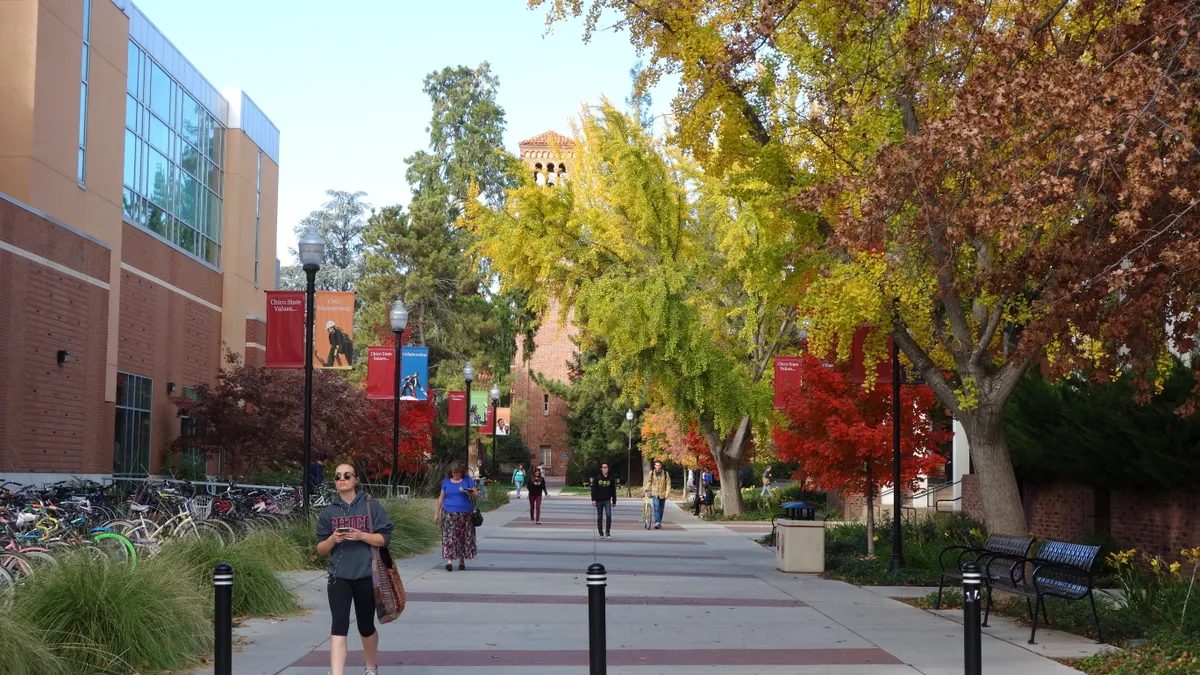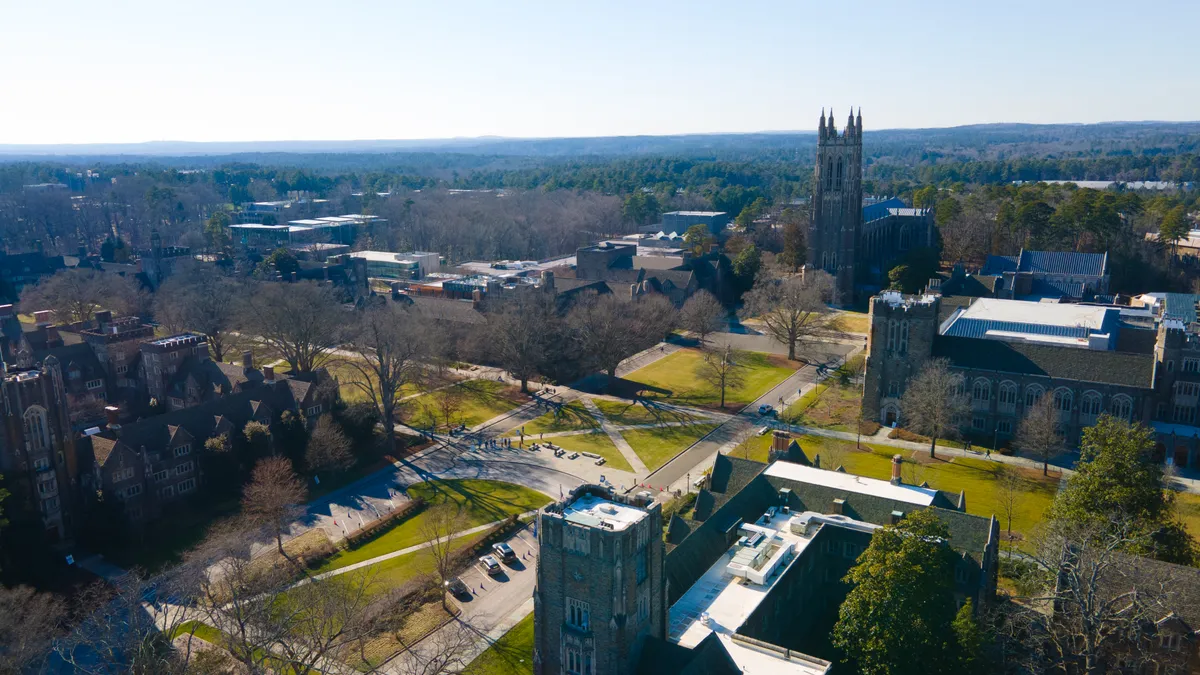Collective bargaining has broken down between the California State University system and a union representing about 29,000 of its faculty and other staff — raising the specter of a strike just as the academic year begins.
The higher education labor movement has boomed over the last couple of years, with prominent strikes in 2023 involving graduate workers at Temple University and the University of Michigan. But such a movement at Cal State, the largest public higher ed system in the U.S., would likely rock the landscape and ignite debate about whether college administrators are acting as good-faith negotiators.
A possible Cal State strike calls back to a walk-out by University of California system academic workers in 2022. At the time, organizers described the strike as the largest in American higher ed history. The UC system has 10 campuses, enrolls roughly 280,000 students and employs 227,000 faculty and staff.
In comparison, the 23-campus Cal State had nearly 458,000 students in fall 2022 but less than a third of the employees, at roughly 53,000 faculty members and staff. It’s also facing an estimated $1.5 billion budget gap.
Earlier in August, negotiators for the California Faculty Association — which also represents other employees like Cal State librarians and coaches — declared to the state’s Public Employment Relations Board that they had reached a bargaining impasse with system officials.
That set off a process in which the employment relations board appoints a mediator for the two parties. If the two sides can’t reach an agreement, then the union could vote to strike.
“We will continue fighting for the transformative contract the CSU needs,” Meghan O’Donnell, a member of the union’s board of directors and a Cal State Monterey Bay lecturer, said in a statement last week.
“Organizing is happening all over the state as students and faculty come back to campus after a sweltering summer of solidarity.”
What are the sticking points?
Both sides have essentially characterized their opposition's contract proposals as disrespectful.
The faculty association asked for a 12% salary bump for the current fiscal year, which the system initially countered with a 12% increase over three years, with a 4% raise for the 2023-24 fiscal year.
When the union wouldn’t budge on its demand for the 12% increase, citing rising costs of living, the system came back with a 5% pay raise for the current fiscal year, which the association also rejected.
Other major sticking points include the union’s call for longer parental leave and gender-neutral restrooms and lactation spaces in each campus building.
Cal State officials argue that all of these measures are too expensive.
The union is seeking 16 weeks of paid parental leave — 10 weeks more than what the system currently offers — which would cost upwards of $20 million if provided to all types of employees in the association, according to estimates Cal State made public this week.
Retrofitting one bathroom can run between $100,000 and $750,000, the system said. It did not provide a cost analysis for lactation rooms but said constructing those and the new restrooms are cost prohibitive.
Cal State “is committed to fair and reasonable compensation for faculty — and all its employees — and will agree to increasing compensation (a recurring cost) so long as it can do so in a fiscally responsible and sustainable way,” officials said in a statement this week.
A system spokesperson did not respond to an additional request for comment Thursday.
The California Faculty Association last ratified a contract in February 2022, which included general salary increases of 4% for the 2021-22 and 2022-23 academic years.
Taking shots
In a public statement this week, Cal State officials said the union moved to an impasse “after only four bargaining sessions” and argued its demands “utterly fail to recognize CSU’s ongoing commitment to these issues, and progress made to date.”
Before that statement, the system had tried a different tactic — a public plea to employees from Interim Chancellor Jolene Koester.
Koester urged faculty to not outright dismiss Cal State’s attempts to bargain in a five-minute video Friday. But, she warned, “if we extend ourselves further, each of the 23 universities will be put in a position where they’re going to be forced to make difficult and painful decisions.”
“They’re going to have to reallocate their already limited financial resources to meet their increased costs of operation,” Koester said, adding that she was making the remarks to ensure faculty are “well-informed of the facts.”
The union on Thursday called the video insincere. And hundreds of largely negative comments poured in on YouTube, with some calling it “tone-deaf” and an attempt “to divide students, faculty, and staff.”
The union couldn’t “have paid for a better announcement to fire up faculty and lecturers for a strike,” one commenter wrote.
Faculty members in the association have flagged the possibility of a strike to students. Language included in their syllabi states they are in a “difficult contract dispute” with administration, but that they would give notice of any work stoppage.
A spending debate
The back-and-forth comes as Cal State attempts to wrangle in its spending.
Its $1.5 billion budget deficit was detailed in a report released in May, which also recommended tuition hikes to make up for it.
In response, Cal State officials proposed a 6% annual tuition increase for the next five years. Full-time undergraduates would pay $7,682 yearly in the 2028-29 academic year. The 2023-24 rate is $5,742 for the year.
Cal State officials are expected to vote on the tuition increase in mid-September.
The proposal has drawn condemnations from students, who questioned the wisdom of Cal State — an engine of social mobility, especially for marginalized groups — jacking up its rates amid tough economic conditions.
The system has also faced accusations of reckless budgeting, criticisms that have arisen anew with union negotiations.
Last year, some Cal State presidents got raises up to about 29%. System officials said the salary increases were partly meant to make up for a pandemic-era pay freeze, but they still caused an uproar among its unions.
And in July, the California Faculty Association ripped into the compensation package for the new Cal State chancellor, Mildred García, who earns a base salary of $795,000, with deferred compensation of $80,000 yearly.
The previous permanent chancellor started with a salary of $625,000 a year, which the association also called exorbitant.
García also receives monthly auto and housing stipends of $1,000 and $8,000, respectively.
“The total is $983,000,” the union said in its July statement. “The chancellor select’s salary is more than what the President of the United States and Governor of California earn annually, combined.”

















